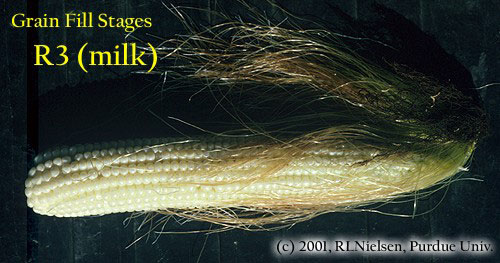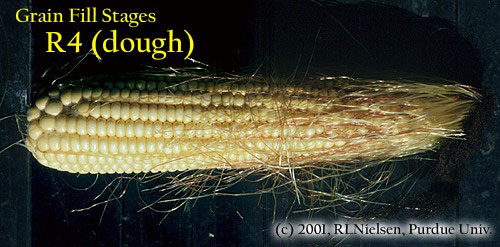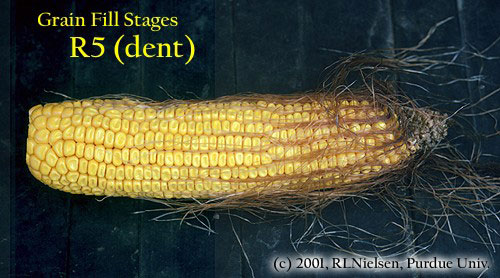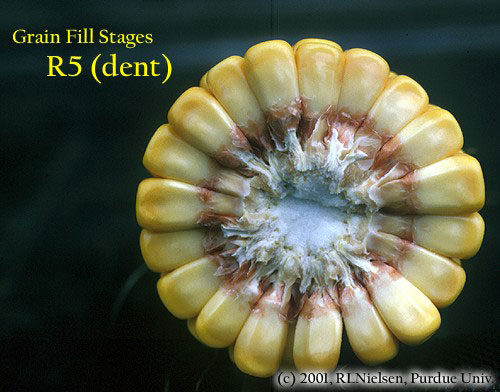Pest & Crop Newsletter, Entomology Extension, Purdue University
Rootworm Beetles Invading Weedy Soybean Fields – (John Obermeyer, Christian Krupke, and Larry Bledsoe)
- Pollinating weeds, especially volunteer corn, may attract large numbers of rootworm beetles.
- Rootworms laying eggs in weedy soybean fields may cause considerable root damage to next year's corn.
- This creates potential first-year corn rootworm problems throughout the state.

Succotash or volunteer corn certainly attract rootworm beetles.
While driving the Indiana countryside, it is obvious that weed control issues still exist in many soybean fields. “Succotash,” soybean fields with volunteer corn are once again becoming a common site as glyphosate-resistant corn increases in use. Consider that rootworm beetles are primarily pollen feeders, think foxtails, ragweeds, lambsquarters, pigweeds, and certainly volunteer corn. Numerous beetles that converge on these “trap” crops will likely lay eggs and threaten next year’s corn roots.
Pest managers, especially those in or beyond the fringe areas of the variant western corn rootworm, are encouraged to investigate weedy patches/fields for the presence of beetles. Female beetles, after mating, often travel considerable distance to feed on pollen and to deposit eggs in the soil. As few as 4,000 volunteer corn plants per acre may attract enough rootworm beetles to lay eggs and cause economic larval damage in next year’s corn.
![]()

Green June Beetle and Japanese Beetle.

Western corn rootworm beetles feeding on giant ragweed pollen
Gigantic Japanese Beetle!?!? – (John Obermeyer and Christian Krupke)
Several inquiries have been received about “huge” Japanese-like beetles seen around farmsteads. No, a mutation of the Japanese beetle has not occurred but rather another related Scarab, the green June beetle, has been seen with more frequency this year.
Green June beetle feed on many plants, as do the Japanese beetle, but they are especially fond of ripe fruit. Peaches, berries, plums, etc. ripening may be subject to clusters of these pest’s feeding frenzy. The beetles may occasionally feed on corn, but significant damage has not been reported. The green June beetle grub, as with the Japanese beetle grub, feed-on decaying matter and grass roots in the soil. However, the green June beetle larva is much larger and creates tunnels as they move about in the soil. These tunnels can significantly disrupt turf and grass pastures. Bottom-line, be alert to these “pretty” beetles attempting to cut into your fruit harvest.
![]()
Click for Table.
Black Light Catch Report.
![]()
Soybean Disease Update - (Gregory Shaner and Andreas Westphal)
- No major problems yet, but several diseases are out there.
Many soybean fields in Indiana have reached the pod development stages of growth. There are no major disease problems, but various diseases are present in low levels in some fields.
Phytophthora root rot is present in some fields. If symptoms of this disease are seen in a field in which the grower planted a resistant variety, this may indicate presence of a race of the fungus that overcomes a particular resistance gene. Races that overcome two widely used resistance genes--Rps1c and Rps1k--are present in Indiana.
Sudden death syndrome (SDS) is starting to appear. In research plots, it has been present since the beginning of July, earlier than in previous years. The wet weather this spring and summer have been conducive for SDS and alertness to its occurrence is indicated.
Several foliar diseases are showing up. Brown spot is common, but restricted to lower leaves. Close examination of plants that had reached the V12 to V13 stage of vegetative growth (R3 on the reproductive growth stage scale) revealed that brown spot was severe up to the fourth trifoliolate from the bottom. There were a few lesions on trifoliolate 5 and perhaps 6, but all the leaves above (trifoliolates 7 through 12 or 13) showed no symptoms. Thus, symptomatic leaves were low in the canopy. Even if healthy, these leaves would no longer receive much sunlight.
Downy mildew is moderately severe on some varieties. Symptoms are distributed throughout the canopy. During humid conditions, sporulating lesions are evident as fluffy masses on the underside of the leaf blade. The upper surface of the leaf opposite these sporulating lesions is pale green to almost yellow.
A few leaves submitted from soybean rust sentinel plots showed symptoms of bacterial pustule or bacterial blight. Bacterial blight is favored by cool weather, so is not likely to develop further in the hot weather that has settled over the state. In contrast, bacterial pustule may continue to develop in hot weather. Wind-driven rain disperses the bacteria that cause both of these diseases.
A few soybean sentinel plot samples had symptoms of frogeye leaf spot. In contrast to the foliar diseases mentioned, frogeye leaf spot has the potential to reduce yields. It is likely that most soybean varieties in Indiana are resistant, but last year some proved to be very susceptible and the same may be true this year. Fields planted to susceptible varieties or to varieties of unknown resistance status should be scouted. Young leaves are most susceptible to infection, so leaves that developed during warm, humid conditions (most leaves that have developed over the past couple of weeks) may show symptoms. There is not much guidance on use of fungicides to control frogeye leaf spot under our conditions, but experience in southern states indicates that treatment around the R3 growth stage is effective.
![]()
Grain Fill Stages in Corn - (Bob Nielsen)
The grain fill period begins with successful pollination and initiation of kernel development, and ends approximately 60 days later when the kernels are physiologically mature. During grain fill, the developing kernels will be the primary sink for concurrent photosynthate produced by the corn plant.
What this means is that the photosynthate demands of the developing kernels will take precedence over that of much of the rest of the plant. In essence, the plant will do all it can to “pump” dry matter into the kernels, sometimes at the expense of the health and maintenance of other plant parts including the roots and lower stalk. A stress-free grain fill period can maximize the yield potential of a crop, while severe stress during grain fill can cause kernel abortion and lightweight grain, and encourage the development of stalk rot.
Kernel development proceeds through several relatively distinct stages (Ritchie et. al., 1993).
Silking Stage (Growth Stage R1)
Some may argue whether silking should be labeled as a kernel growth stage, but nonetheless silk emergence is technically the first identifiable stage of the reproductive period. Silks remain receptive to pollen grain germination up to 10 days after silk emergence (Nielsen, 2005a). Silk receptivity decreases rapidly after 10 days if pollination has not yet occurred. Natural senescence of silk tissue over time results in collapsed tissue that restricts continued growth of the pollen tube. Silk emergence usually occurs in close synchrony with pollen shed (Nielsen, 2005b), so that duration of silk receptivity is normally not a concern. Failure of silks to emerge in the first place (for example, in response to silkballing or severe drought stress) does not bode well for successful pollination.


Kernel Blister Stage (Growth Stage R2)
About 10 to 14 days after silking, the developing kernels are whitish “blisters” on the cob and contain abundant clear fluid. The ear silks are mostly brown and drying rapidly. Some starch is beginning to accumulate in the endosperm. The radicle root, coleoptile, and first embryonic leaf have formed in the embryo by the blister stage. Severe stress can easily abort kernels at pre-blister and blister stages. Kernel moisture content is approximately 85 percent.


Kernel Milk Stage (R3)
About 18 to 22 days after silking, the kernels are mostly yellow and contain “milky” white fluid. The milk stage of development is the infamous “roasting ear” stage, that stage where you will find die-hard corn aficionados standing out in their field nibbling on these delectable morsels. Starch continues to accumulate in the endosperm. Endosperm cell division is nearly complete and continued growth is mostly due to cell expansion and starch accumulation. Severe stress can still abort kernels, although not as easily as at the blister stage. Kernel moisture content is approximately 80 percent.


Kernel Dough Stage (R4)
About 24 to 28 days after silking, the kernel’s milky inner fluid is changing to a “doughy” consistency as starch accumulation continues in the endosperm. The shelled cob is now light red or pink. By dough stage, four embryonic leaves have formed and about 1/2 of the mature kernel dry weight is now in place. Kernel abortion is much less likely once kernels have reached early dough stage, but severe stress can continue to affect eventual yield by reducing kernel weight. Kernel moisture content is approximately 70 percent.


Kernel Dent Stage (R5)
About 35 to 42 days after silking, all or nearly all of the kernels are denting near their crowns. The fifth (and last) embryonic leaf and lateral seminal roots form just prior to the dent stage. A distinct horizontal line appears near the dent end of the kernel and slowly progresses to the tip end of the kernel over the next 3 weeks or so. This line is called the “milk line” and marks the boundary between the liquid (milky) and solid (starchy) areas of the maturing kernels. Severe stress can continue to limit kernel dry weight accumulation. Kernel moisture content at the beginning of the dent stage is approximately 55 percent.


Physiological Maturity (R6)
About 55 to 65 days after silking, kernel dry weight usually reaches its maximum and kernels are said to be physiologically mature and safe from frost. Physiological maturity occurs shortly after the kernel milk line disappears and just before the kernel black layer forms at the tip of the kernels. Severe stress after physiological maturity has little effect on grain yield, unless the integrity of the stalk or ear is compromised (e.g., damage from European corn borer or stalk rots). Kernel moisture content at physiological maturity averages 30 percent, but can vary from 25 to 40 percent grain moisture.


Harvest Maturity
While not strictly a stage of grain development, harvest maturity is often defined as that grain moisture content where harvest can occur with minimal kernel damage and mechanical harvest loss. Harvest maturity is usually considered to be near 25 percent grain moisture.
Related References
Nielsen, R.L. (Bob). 2004. Yield Loss Potential During Grain Fill. Corny News Network, Purdue Univ. Online at http://www.kingcorn.org/news/articles.04/GrainFillStress-0705.html. (URL verified 7/5/04)
Nielsen, R.L. (Bob). 2005a. Silk Emergence. Corny News Network, Purdue Univ. Online at http://www.kingcorn.org/news/articles.05/Silks-0704.html. (URL verified 7/15/05)
Nielsen, R.L. (Bob). 2005b. Tassel Emergence & Pollen Shed. Corny News Network, Purdue Univ. Online at http://www.kingcorn.org/news/articles.05/Tassels-0704.html. (URL verified 7/15/05)
Ritchie, S.W., J.J. Hanway, and G.O. Benson. 1993. How a Corn Plant Develops. Iowa State Univ. Sp. Rpt. No. 48. Online at http://maize.agron.iastate.edu/corngrows.html. (last verified 7/5/04).
For other Corny News Network articles, browse through the CNN Archives at http://www.kingcorn.org/news/archive.html.
For other information about corn, take a look at the Corn Growers’ Guidebook at http://www.kingcorn.org![]()


